Thorne Vallis
About the Author
Thorne Vallis doesn’t remember a time when his fingers weren’t smudged with copper dust. Raised on the edge of an old mining town in Nevada, he grew up trading bottle caps for buffalo nickels and thought every rusted object held a secret.
When not writing for Obverse Quarterly, arguing mint mark theory in late-night forums, or composing a rare 1976 2 dollar bill value chart, he’s known to vanish into county archives with a notebook, a jeweler’s loupe, and black coffee.
Thorne founded The Coin Atlas and How much is a $2 bill from 1976 worth? not to teach, but to provoke questions no grading guide ever answers.
His dog is named Dime.

Connect with Thorne:



How Much Is a $2 Dollar Bill Worth from 1976?
2$ Bill 1976 Design Overview
Is a 1976 2 dollar bill worth anything? Before the answer, we need to understand what this banknote is.
The 1976 $2 Federal Reserve Note marked the revival of the $2 denomination after a decade-long hiatus. Issued to commemorate the U.S. Bicentennial (1776–1976), it features a historically rich design both on the obverse and reverse.
Obverse Design (Front)
| Element | Description |
| Portrait | Thomas Jefferson, 3rd U.S. President |
| Engraver | Charles Burt |
| Seal | Green Treasury Seal (Federal Reserve Note) |
| Serial Numbers | Printed in green; appear twice |
| Signatures | Treasurer of the U.S. & Secretary of the Treasury |
| Border | Ornate classical border design |
| District Mark | One of 12 Federal Reserve Bank letters (e.g., A for Boston) |
Note: Unlike earlier red-seal Legal Tender Notes, the 1976 version has a green seal, indicating it’s a Federal Reserve Note, not Legal Tender.
Reverse Design (Back)
| Element | Description |
| Scene | Signing of the Declaration of Independence |
| Source Artwork | Based on the 1817 painting by John Trumbull |
| Depicted Figures | 42 of the 56 signers of the Declaration |
| Engraver | Bureau of Engraving and Printing (BEP) adaptation |
| Theme | Commemoration of the U.S. Bicentennial |
| Inscriptions | “Declaration of Independence, 1776” & “Two Dollars” |
- First circulated $2 note since 1966
- No Bicentennial markings on the bill itself despite the theme
- Only Series 1976 2 dollar bill (and later 1995, 2003, etc.) share this reverse design
- Printing began on April 13, 1976 — Jefferson’s birthday
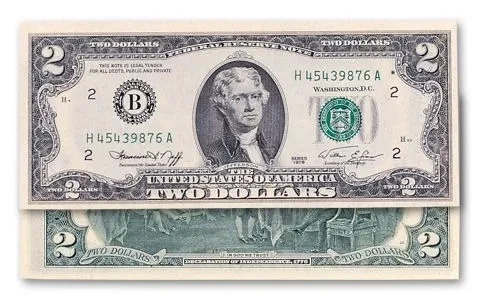
Historical Background of the $2 Dollar Bill 1976
The reintroduction of the $2 bill in 1976 was a calculated effort by the U.S. Treasury to rekindle interest in an often-overlooked denomination while honoring America’s Bicentennial.
Why 1976?
The year marked 200 years since the signing of the Declaration of Independence. The federal government planned large-scale commemorations across the country—parades, coin releases, postage stamps, and yes, a freshly reimagined $2 bill.
While the $2 denomination had been printed sporadically since the 1860s, its use had dramatically declined by the 1960s. Seen as awkward for transactions and often mistaken for counterfeit, it quietly disappeared after the 1966 red-seal Legal Tender Note series.
But in 1976, with the Bicentennial fever gripping the nation, the Treasury sensed an opportunity:
- Revive the $2 bill to mark a symbolic piece
- Reduce printing costs by using higher-denomination notes instead of two $1 bills
- Encourage collectors to hoard them, easing currency circulation demands
Public Reaction
The reissue launched on April 13, 1976—Thomas Jefferson’s birthday—with official ceremonies at Monticello. However, the rollout faced public confusion:
- Many thought it was a limited edition, and began hoarding it.
- Others mistakenly believed it had collectible or automatic resale 2 dollar bill 1976 worth.
- Some retailers and banks refused to accept or circulate them.
Ironically, the public’s misunderstanding turned the 1976 $2 bill into exactly what the Treasury hoped for—a collectible item with a rather high 1976 two dollar bill value with light circulation.
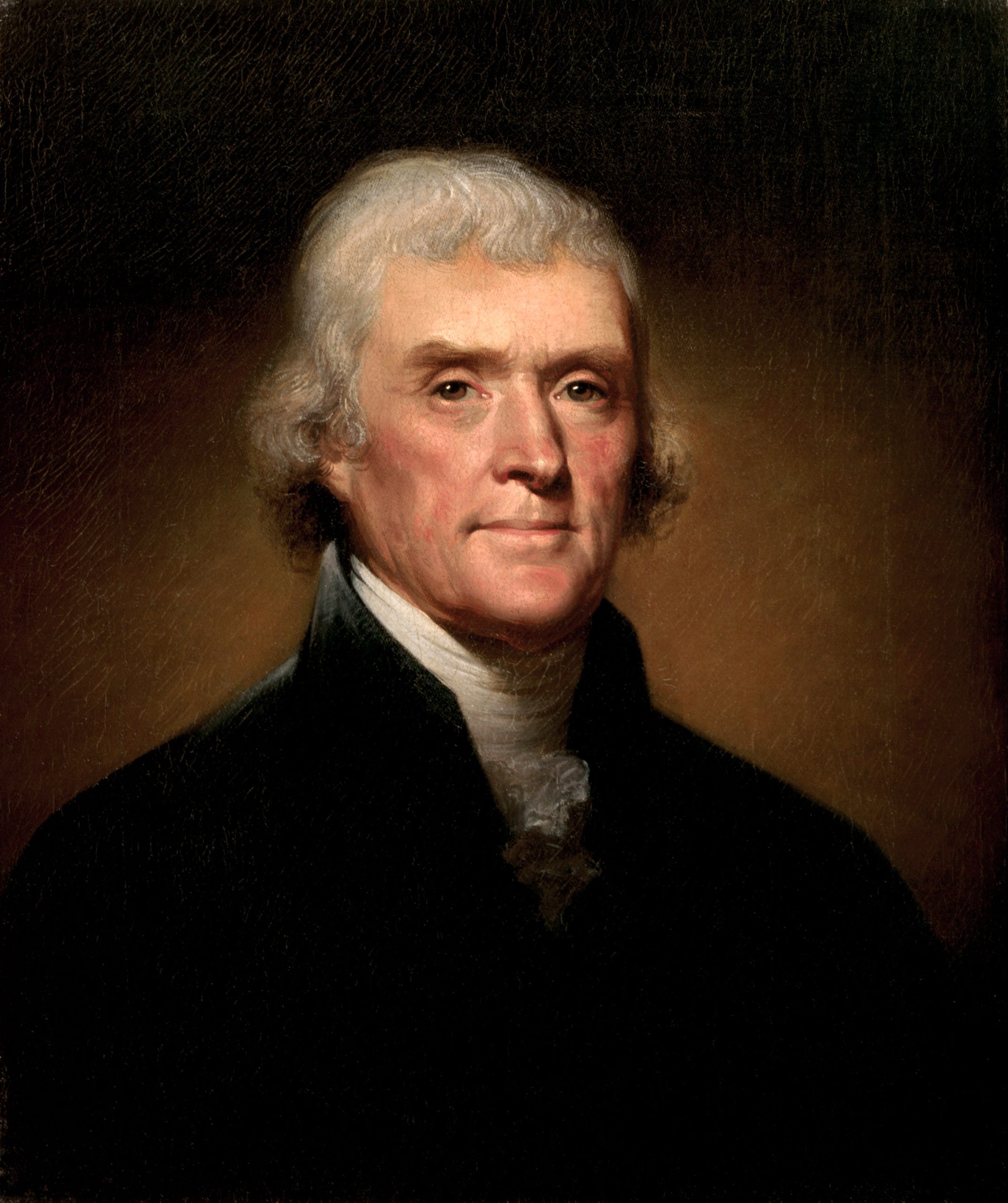
Legacy Today
Though still legal tender, most 1976 Series 2 dollar bill pieces remain lightly circulated or unspent, often found in pristine condition in collector albums.
Their reverse design, adapted from John Trumbull’s 1817 painting, has never been reused on any other denomination. So, it’s a unique commemorative hybrid of history and currency.
How Much Is a 1976 $2 Bill Worth?
| Feature | Condition | Estimated Two Dollar Bill 1976 Value (USD) | Notes |
|---|---|---|---|
| Standard Note (Common Districts)(e.g., A-Boston, F-Atlanta, L-San Francisco) | Circulated | $2.00 – $2.50 | No premium unless uncirculated |
| Crisp Uncirculated (CU) | $4.00 – $8.00 | Uncirculated examples are widely hoarded | |
| Gem CU (65+ grade) | $8.00 – $15.00 | Higher $2 dollar bill worth 1976 if certified | |
| Low Print Districts(e.g., H-St. Louis, I-Minneapolis) | Circulated | $2.50 – $4.00 | Slight premium even in lower grades |
| CU | $7.00 – $12.00 | Higher interest due to scarcity | |
| Star Notes | $10.00 – $30.00 | Scarce; star replaces serial number rare 1976 2 dollar bill error | |
| Star Notes (Any District) | Circulated | $8.00 – $15.00 | Considerably more valuable if crisp or rare district |
| CU | $20.00 – $50.00 | Some rare combos (e.g., H★, K★) may exceed the $2 bill value 1976 of $100 in auctions | |
| Uncut Sheets (4 or 32 Notes) | Uncut | $15.00 – $80.00+ | Sold directly by BEP in 1976; highly collectible in original folders |
| Postmarked Notes(Stamped April 13, 1976) | CU | $10.00 – $25.00 | Popular as souvenirs for the Bicentennial release |
| Error Notes (Offset, Inverted) | Any | $50.00 – $1,000+ | What is a 1976 $2 bill worth of this type? Errors can fetch hundreds depending on visibility and rarity |
Collector Tip from Thorne Vallis:
- Star Notes from districts like I-Minneapolis and J-Kansas City are especially scarce and valuable.
- Serial Numbers like “00000001,” repeaters (e.g., 12344321), or “bicentennial” patterns (e.g., 17761776) can add significant 2 dollar bill value 1976.
Explanation of the Value of 1976 2 Dollar Bill
1. Standard Notes (Common Districts – A, B, F, L)
- These are the most frequently printed and found notes.
- Circulated examples are still worth face value of 2 dollar bill 1976 ($2.00–$2.50) because they’re not rare or unique.
- Crisp Uncirculated (CU) notes, however, appeal to collectors for their pristine state. The value of $2 bill 1976 may fetch $4–$8.
- Gem CU (graded 65 or above), especially if certified by PCGS or PMG, can reach $15 due to grading premiums.

2. Low Print Run Districts (H-St. Louis, I-Minneapolis)
- Notes from these districts were printed in smaller numbers.
- Even circulated examples can reach $4.
- In uncirculated condition, they’re more desirable and can sell for $7–$12.
- These become more valuable if paired with unique serial numbers or star notes. They can even be found in a rare 1976 $2 dollar bill value chart.
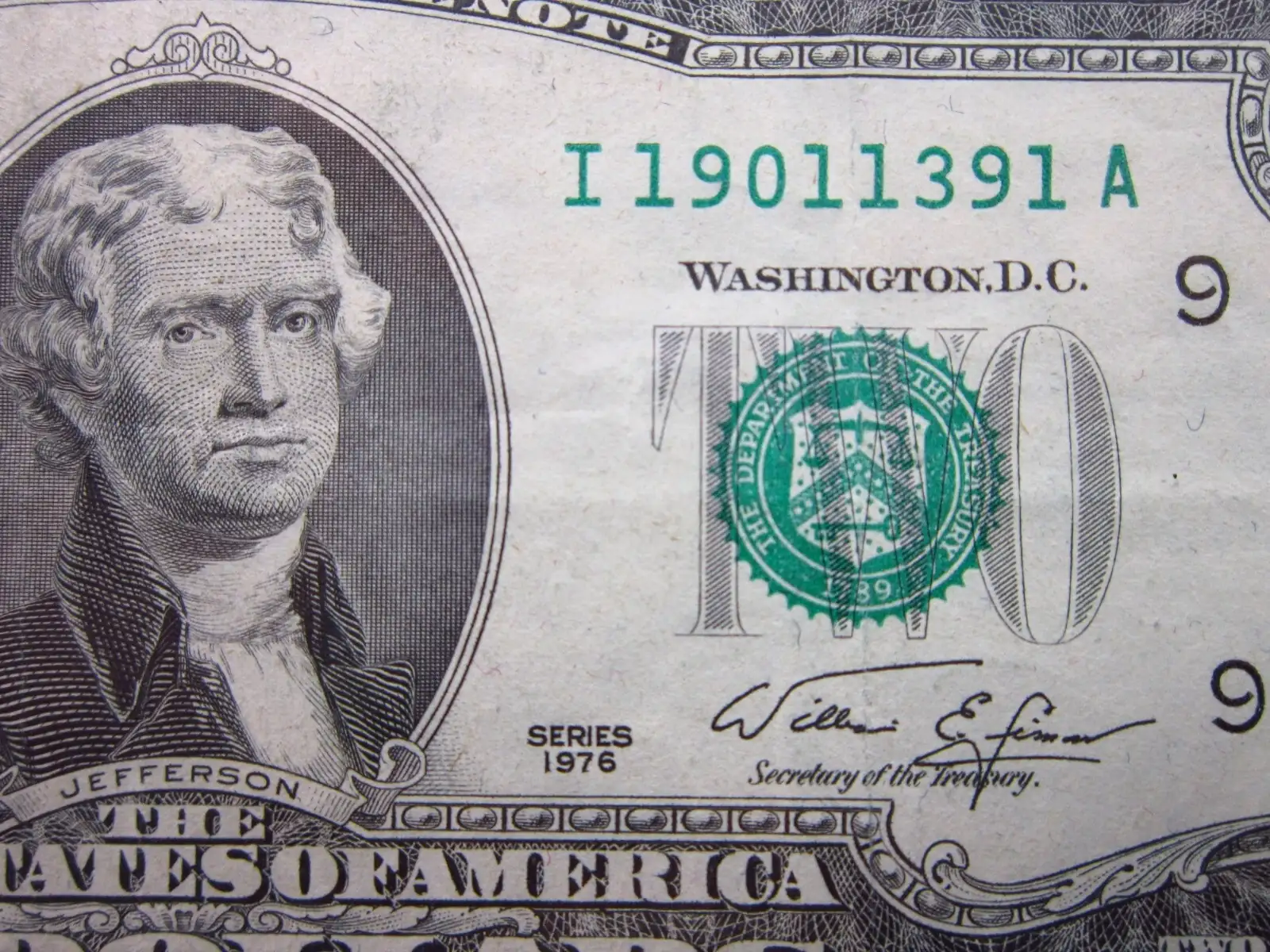
3. Star Notes
- Star notes replace misprinted bills and have a star ★ at the end of the serial number.
- They are much scarcer, especially from certain districts like H★ or K★.
- Circulated star notes start around $8–$15.
- In uncirculated condition, they can easily sell for $30–$50, and rare combos (e.g., I★) may exceed $100 at auction.
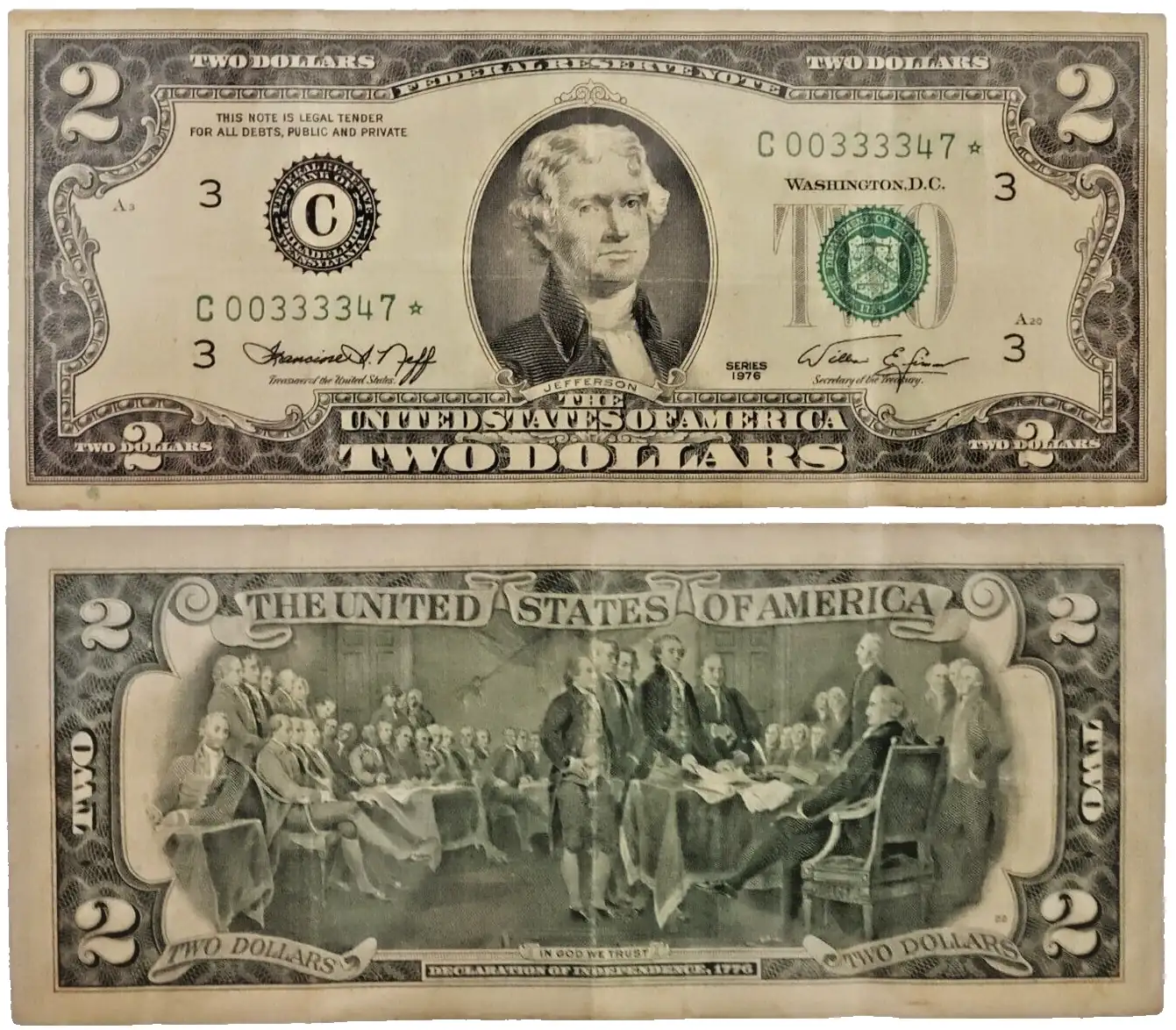
4. Uncut Sheets
- In 1976, the Bureau of Engraving and Printing sold uncut sheets as collectibles.
- These were sold in 4-note and 32-note sheets.
- Values depend on format and condition: $15 for 4-note sheets, $60–$80+ for larger uncut sheets in mint packaging.
- These are valued higher due to their display and presentation appeal.
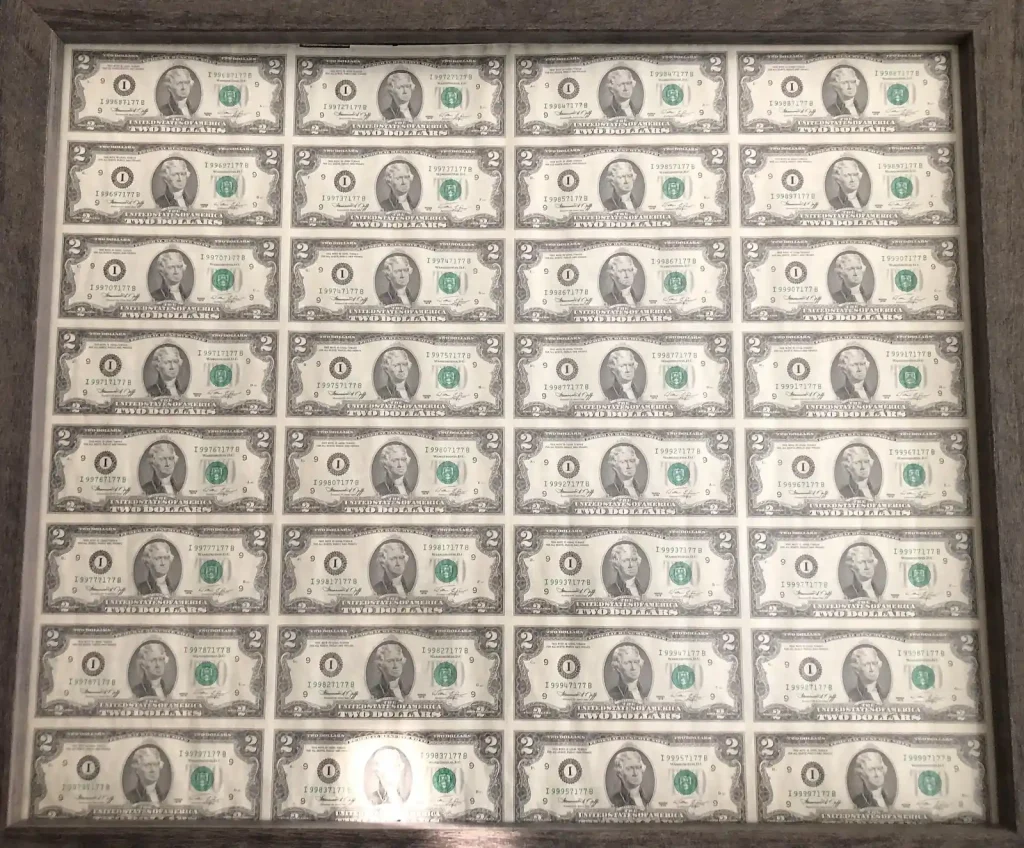
5. Postmarked Notes (April 13, 1976)
- Some collectors had their new $2 bills stamped and canceled by post offices on Jefferson’s birthday, the day of release.
- While technically defaced for currency, these are now novelty collectibles.
- Value depends on clarity of the postmark and condition—typically $10–$25 for crisp examples. Always check the 1976 $2 bill value chart.
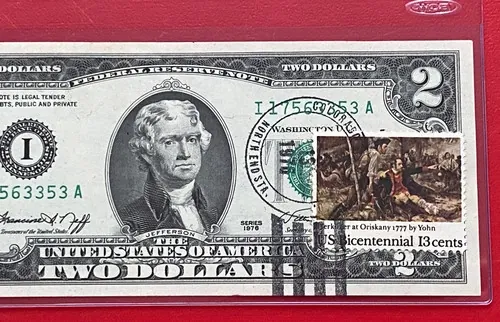
6. Error Notes
- These include misaligned printing, offset ink transfers, inverted seals, or fold-over errors.
- Errors are highly sought after in all denominations.
- How much is a 2 dollar bill worth from 1976 with errors? Common examples start at $50; rare specimens may command $500 to over $1,000, especially when graded.
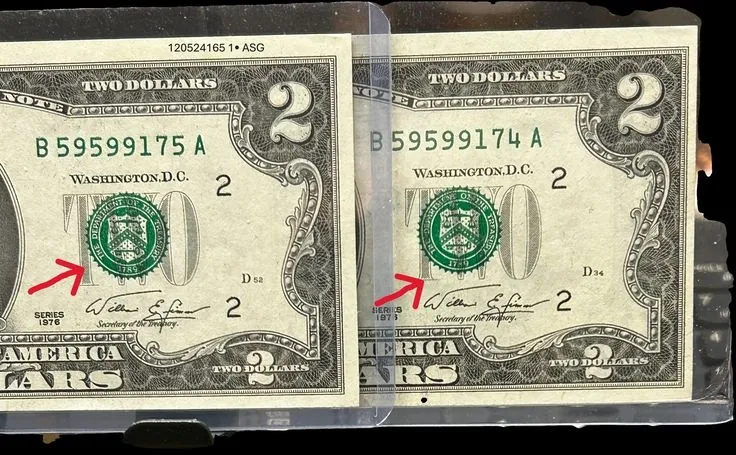
1976 $2 Dollar Bill Errors
Although the 1976 $2 bill was printed with modern equipment, a number of printing errors slipped through quality control, making them highly collectible today. These are often worth multiples of face $2 bill 1976 value—sometimes hundreds or even thousands.
| Error Type | Description | How Much Is a 1976 2 Dollar Bill Worth? | Rarity |
| Offset Printing Error | Design from one side accidentally prints faintly on the opposite side. | $100 – $300+ | Uncommon |
| Inverted Overprint | Serial numbers or seals printed upside-down relative to the main design. | $300 – $1,200+ | Rare |
| Misaligned Serial Numbers | Serial number shifted too far left, right, up, or down. | $50 – $150 | Moderately common |
| Fold-Over Error | Part of the bill is folded during printing, resulting in blank or misprinted zones. | $250 – $750+ | Rare |
| Cutting Error (Miscut) | Bill is cut off-center or includes part of another note. | $80 – $300+ | Semi-rare |
| Blank Back or Front | Entire side missing due to print stage failure. | $500 – $2,000+ | Very rare |
| Multiple Print Shifts | Several elements (like the seal, portrait, and serial) printed misaligned. | $200 – $600 | Rare |
| Ink Smears/Color Bleeds | Excess ink causes blurry sections, or green ink bleeds through the paper. | $75 – $250 | Uncommon |
How to Spot Errors
- Use magnification to examine serial numbers and seal placements.
- Look for misalignments near the portrait, borders, or reverse image.
- Compare to a normal note to detect subtle overprints or offset transfers.
- Light test: Hold the note to the light to spot paper inconsistencies or folded-over areas.
1976 2 Dollar Bill Serial Number Lookup Guide
Where to Find the Serial Number
Each 1976 $2 bill has:
- Two matching serial numbers, printed in green ink.
- Located on the top right and bottom left corners of the obverse (front).
- Format: Prefix Letter + 8 Digits + Suffix Letter (e.g., D12345678A)
How to Decode the Serial Number
| Part | Meaning |
| Prefix Letter | Indicates the Federal Reserve Bank (A = Boston, B = New York, etc.) |
| 8 Digits | Unique identifying number of the note |
| Suffix Letter | Denotes block; used to avoid repeating serials |
| Star Symbol ★ | Replaces suffix letter if the note is a replacement note (i.e., error fixed) |
1976 $2 Bill Value by Serial Number
| Serial Number Type | Example | Why It’s Valuable | Estimated 2 Dollar Bill 1976 Value (CU) |
| Low Numbers | A00000001A | First notes printed; extremely collectible | $500 – $1,000+ |
| High Numbers | L99999999A | End of series; rare and highly prized | $300 – $600 |
| Repeater Numbers | C12341234D | Symmetrical or patterned | $50 – $200+ |
| Radar Numbers | F12233221H | Reads same forward and backward | $100 – $400 |
| Binary Numbers | B01010101C | Uses only 1s and 0s | $100 – $300 |
| Ladders | G12345678A | Perfect ascending/descending sequence | $250 – $750+ |
| Solid Numbers | K77777777A | All digits the same | $400 – $1,500+ |
| Star Notes | E12345678★ | Replacement note from error correction | $20 – $500+ |
How to Look It Up
Manual Method
- Compare your note to online databases or 1976 $2 dollar bill serial number lookup worth charts from collector forums.
- Cross-check the Federal Reserve District, serial pattern, and suffix for rarity.

Use an App or Online Tool
Tools like MyCurrencyCollection, USPaperMoney.info, or the Coin ID Scanner app (for coins only) can:
- Instantly identify star notes
- Flag patterns (ladders, radars, binaries)
- Provide estimates answering how much is a 2 dollar bill from 1976 worth
- Show print runs and rarity by serial number block
- Act as a 1976 $2 dollar bill serial number lookup free of charge
If your 1976 $2 bill has a unique or patterned serial number, and is in Crisp Uncirculated (CU) condition, consider getting it graded and encapsulated. Certified notes with rare serials can command multiples of face two dollar bill value 1976 at auctions.
So, Is a 1976 $2 Bill Worth Anything?
Yes—but it depends entirely on the details. While most 1976 $2 bills in circulated condition are still worth just face value, some examples can be worth hundreds or even thousands depending on:
- Condition — Uncirculated bills are significantly more valuable.
- Star Notes — Replacement notes are rarer and often have a higher value of a 1976 $2 bill.
- Serial Numbers — Low, fancy, or unique numbers (like radars or ladders) raise the price. You may use a 1976 $2 bill serial number lookup if doubt.
- District Rarity — Notes from certain Federal Reserve districts have lower print runs.
- Printing Errors — Mistakes like offset ink or miscuts increase the value of 1976 $2 bill.
- Postmarked First Day Issues — Commemorative versions are always more desirable and more expensive.
Frequently Asked Questions
Are there different paper types or watermarks?
No. The 1976 $2 bills were printed on standard U.S. currency paper—a blend of 75% cotton and 25% linen.
There are no watermarks or security threads like in modern bills, which can make them easier to counterfeit—but also easier to spot when fake (based on texture, ink, or printing quality).
How do I store a 1976 $2 bill safely?
Use acid-free currency sleeves or archival-grade holders that protect against moisture, UV light, and oils from skin contact. Avoid folding or paper-clipping bills, especially if they’re in uncirculated or star note condition.
If the bill is valuable, consider professional grading by PMG or PCGS for certification and encapsulation.
What is the difference between “Series 1976” and printing dates?
“Series 1976” appears on all notes of this type, but doesn’t mean the note was printed in 1976. Many were printed well into the 1980s.
The series date only changes when a new design or a new signature combination (Treasury Secretary & Treasurer) is introduced.
So a 1976 note could’ve been printed years later if no series update occurred.
Can a 1976 $2 bill be graded if it has a postmark?
Yes, but it will often be graded as an “EPQ” note without numerical grading, or noted as a “Souvenir Cancelled” issue. These are still collectible—especially with clear postmarks dated April 13, 1976, Jefferson’s birthday and the official release day.
How many 1976 $2 bills were printed?
Approximately 590 million notes were printed across all 12 Federal Reserve Banks. While this isn’t a low number by general standards, many were hoarded by the public during the Bicentennial year, resulting in a disproportionate number of uncirculated examples still in existence.
Is it better to collect single notes or sheets?
Both have value:
- Single notes (especially with rare serials or star notes) are easier to grade and resell (check the 1976 2$ bill worth first).
- Uncut sheets appeal to display collectors and are often sold in 4-, 8-, or 32-note configurations. Original packaging and provenance boost sheet value.